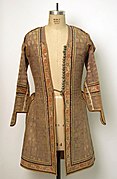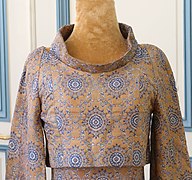|
Persian clothing
  Traditional Persian clothing is the historical costume of the Persian people, and of ancient Persia (now Iran) before the 1930s Pahlavi dynasty. Historically, the fabric and color of clothing was very important.[1] During the Achaemenian period (550–330 BC), Persian clothing started to reflect social status and eminence, the climate of the region, and the season. The design philosophy for ancient clothing was a marriage of both function and aesthetics.[1] Images of Persian clothing examples can be seen in ancient art and Persian miniature paintings.[2] Persian miniatures can employ both vivid and muted colors for clothing, although the colors of paint pigment often do not match the colors of dyes. Traditional Persian clothing is seldom worn in urban areas in modern times but has been well preserved in texts and paintings throughout history.[citation needed] HistoryClothing in Persia is divided into several historical periods, however little is known about the earliest history.[3][4] The exact date of the emergence of weaving in Iran is not yet known, but it is likely to coincide with the emergence of civilization.[5] There are historical discoveries in northern Iran from about 6,000 BC that refer to wool weaving at the time. Other discoveries in central Iran dating back to 4200 BC have shown that the animals' skin has not been the only clothing worn on the Iranian plateau since those years. The clothing of ancient Iran took an advanced form, with the fabric and color of clothing becoming very important at that time. During the Achaemenian period, clothing varied depending on social status, eminence, the climate of the region, and the season.
PantsA wide belt was often worn called Kamarband, from which English gets the word "cummerbund".[6] Chaqchur Chaqchur (footed trousers, or čāqčūr), were long pants often in thin black fabric, primarily worn by women, but in later history, they were worn by men.[7] Chaqchur came in two distinct styles, the first style was loose wide-legged trousers with a waistband, ending in stockings (a balloon leg), which covers the body from waist to toes; the second style was similar to a stirrup legging.[7] By the late Qajar dynasty (early 20th century), chaqchur were no longer in style.[7] ShalvarThe shalvar pant (sirwal, šalvâr, or "harem pant") had a full leg and was fit at the ankle and was worn by both men and women, coming in various fabrics styles and colors.[7] TonokaTonoka (tonbān) was a leather pant worn for traditional wrestling and athletics, the style is tight at the waist and just below the knees, and sometimes it had decorative details. The tonoka could have details such as small mirrors sewn over the kneecaps (to display the pant wearer's confidence in their win), or embroidered loops of rough cotton cord to chafe the opponent.[7] Dresses and robesAbaThe ʿabāʾ (also ʿabāʾa, and abaya) in Persia was an outerwear garment made of coarse wool with an open in front, and typically is sleeveless but with large armholes (a box-shaped garment with holes for the head, arms and legs).[7] In Iran, the ʿabāʾ is primarily worn by Muslim male religious scholars, a practice that started in the Zand period (late 18th century).[8] KaftanḴaftān a variant of the robe or tunic, and it was used in ancient Persia as a battle dress.[7] The battle variety featured a double layer of heavy fabric, quilted and lined with silk.[7] The ḵaftān was worn under a zereh (chain mail coat).[7] Coats and cloaks KandysKandys (or Median robe) was a three-quarter-length Persian coat, although in its earliest known form in 4th–5th century BC it was shaped more like a cloak which could have decorative sleeves, only used formal settings.[9] The Persian kandys were often purple color, or made from leather and skins.[10] Encyclopædia Iranica has stated many scholars believe kandys, along with a long-sleeved coat called a sárapis and long trousers called anaxyrides, formed the riding dress of the Medes people; which was portrayed in the Persepolis reliefs.[10] It's possible it was an article of clothing associated with nobility.[10] Chador, hijab, and jilbabSome scholars argue that it was Cyrus the Great who, more than a thousand years before Islam, began the practice of covering women to protect their chastity. The theory holds that the veil then passed from the Achaemenids to the Seleucids and was in turn adopted by the Byzantines, and finally transformed into the hijab by the Arabs, who spread it all over the Muslim world.[11] The Safavid dynasty centralized Iran and declared Shia Islam as the official religion, which led to the widespread adoption of hijab by women in the country. Shia Islam served as a tool for the Safavids to consolidate the diverse ethnic groups under their authority and to differentiate themselves from their Sunni Muslim adversaries.[12] Covering the hair has thus long been customary for women in Iran. Iranians generally refer to jilbab by the Persian appellation chador.
Footwear GaleshGalesh (Persian: گالش) are an ancient style of handwoven shoes, that were once found in Northern Iran.[13] Persian heeled bootsAncient Persians used to wear shagreen horse leather high-heeled boots.[14] These heeled boots were created for a strong grip in the stirrup while horse riding, and they were not used for walking.[14] The Achaemenid Empire cavalry had used these boots, and they can be traced as far back as the 10th century.[14][15] See also
References
External linksWikimedia Commons has media related to Clothing of ancient Iran. |






